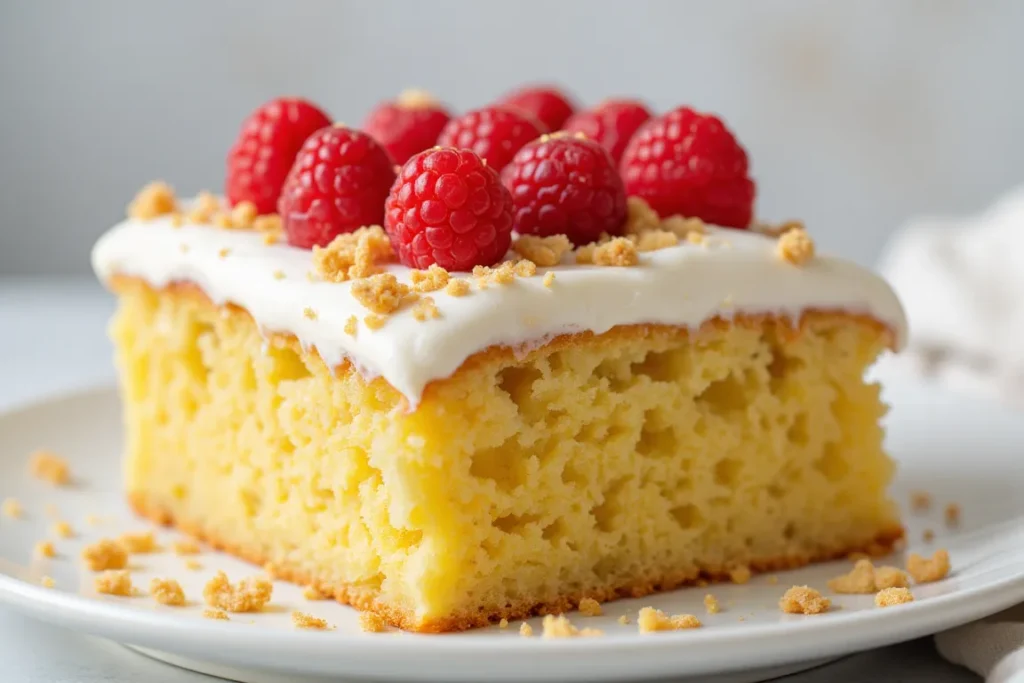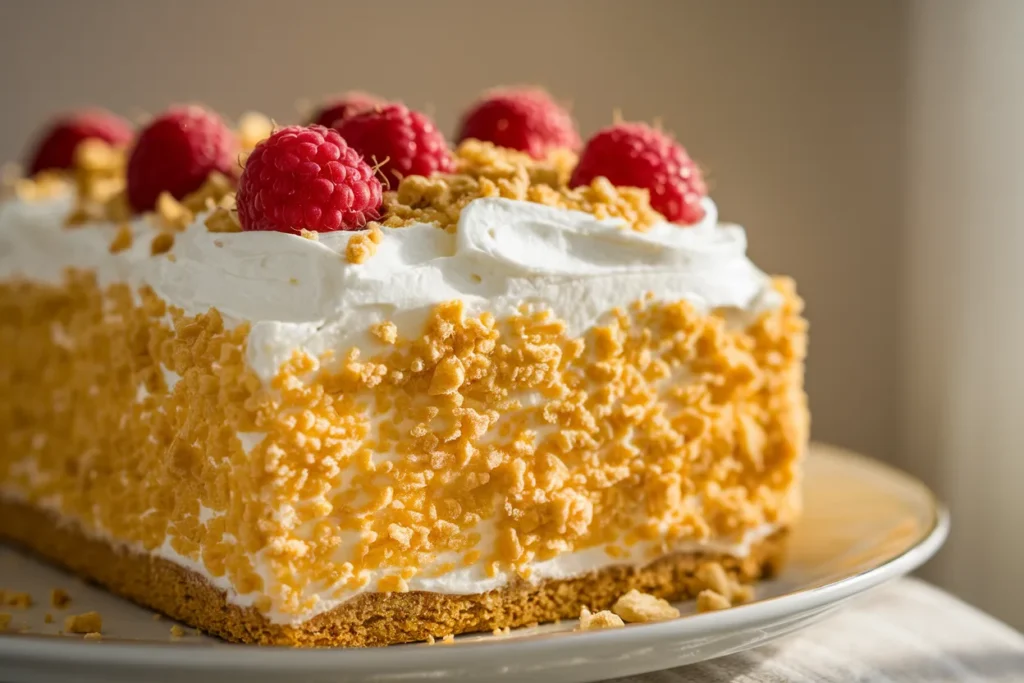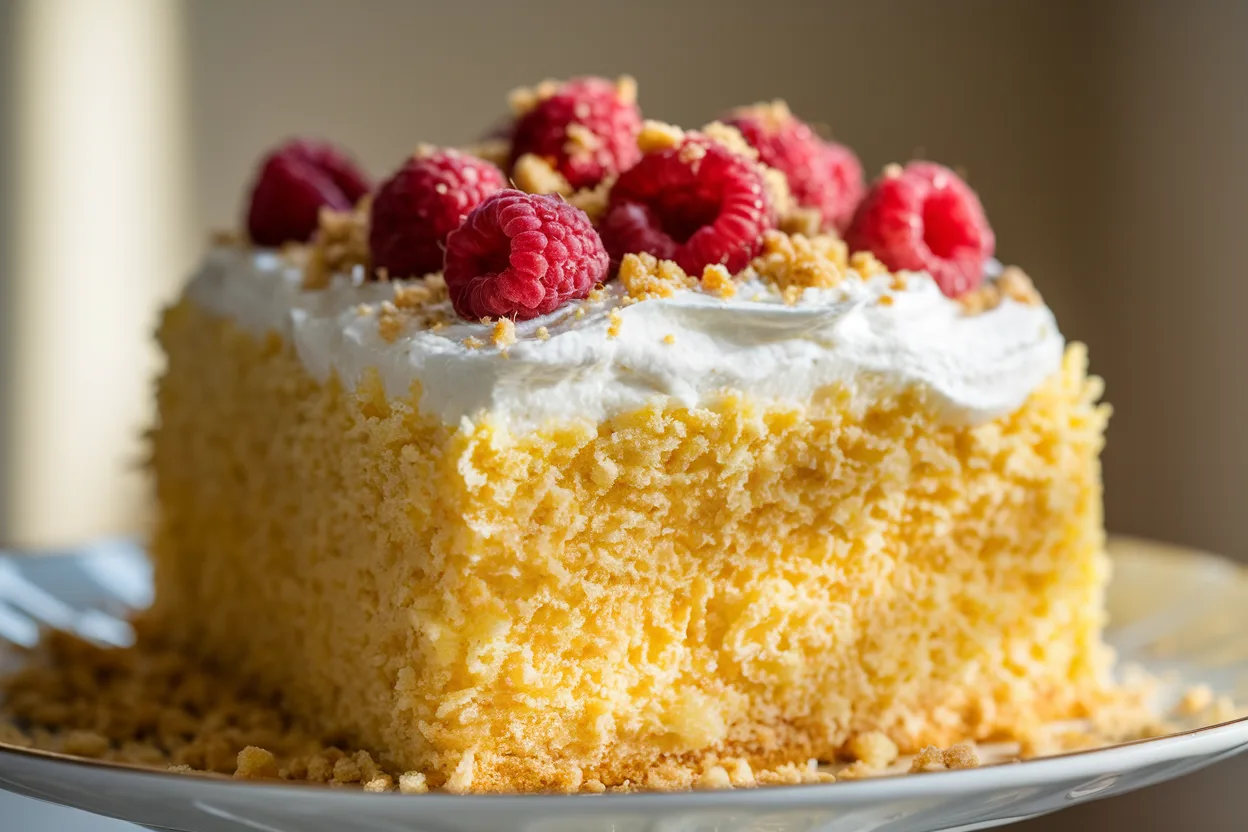A kefir sheet cake is a moist, tender dessert made using kefir—a fermented milk product known for its tangy flavor and probiotic benefits. This cake combines simplicity with unique flavors, making it an excellent choice for casual gatherings or indulgent treats. Its sheet cake format makes it easy to bake, frost, and serve, adding to its popularity.
Why You Need a Recipe Card for This Dessert
Having a recipe card for kefir sheet cake ensures you have all the details to replicate its perfect texture and tangy-sweet flavor every time. A recipe card provides precise measurements, substitutions, and tips for creating this delightful cake, whether you’re a beginner or an experienced baker.
The Origins of Kefir Sheet Cake ”kefir sheet cake recipe ”
History of Kefir in Baking
Kefir has a long history as a staple in Eastern European and Middle Eastern cuisines. Originally made by fermenting milk with kefir grains, it was prized for its health benefits and versatility in cooking and baking. Its natural acidity has been used to tenderize doughs and batters, creating soft, flavorful baked goods.
Evolution of the Sheet Cake Concept
Sheet cakes gained popularity in the 20th century as a practical, crowd-pleasing dessert. Unlike layered cakes, sheet cakes are baked in a single rectangular pan, making them easy to frost and cut into servings. The incorporation of kefir into this format combines the efficiency of sheet cakes with the nutritional benefits and flavor complexity of kefir.
Why Use Kefir in Baking?
Nutritional Benefits of Kefir
Kefir is a powerhouse of nutrients, containing probiotics, calcium, protein, and vitamins B12 and K2. These contribute to improved gut health, bone strength, and overall wellness, making it a valuable ingredient in desserts.
The Role of Kefir in Cake Texture and Flavor
- Moisture and Tenderness: Kefir’s acidity reacts with leavening agents like baking soda, creating a lighter, fluffier texture.
- Flavor Enhancement: Its tangy undertone balances the sweetness of the cake, offering a unique depth of flavor.
- Versatility: Kefir works well with various flavor profiles, from chocolate to citrus and spices.
Essential Ingredients for Kefir Sheet Cake kefir sheet cake recipe
Comprehensive List of Ingredients
- 250ml kefir: The star ingredient, providing moisture and tang.
- 200g all-purpose flour: The base of the cake.
- 150g granulated sugar: Adds sweetness.
- 80ml vegetable oil: Ensures a moist texture.
- 2 large eggs: Provides structure and richness.
- 5g baking soda: Reacts with kefir for leavening.
- 5g baking powder: Adds additional lift.
- Pinch of salt: Enhances overall flavor.
- Flavorings (optional): Vanilla extract, citrus zest, or cocoa powder for variety.
Ingredient Substitutes for Dietary Preferences
- Kefir: Substitute with plant-based kefir or buttermilk for a dairy-free option.
- Vegetable Oil: Replace with melted coconut oil or applesauce for a healthier twist.
- Sugar: Use coconut sugar or a sweetener alternative like erythritol.
- Flour: Swap with gluten-free all-purpose flour for a gluten-free version.
By understanding the origins, benefits, and key ingredients of a kefir sheet cake, you’re well on your way to creating a dessert that’s as nutritious as it is delicious.Tools You Need to Bake a Perfect Kefir Sheet Cake

Baking Essentials
- Mixing Bowls: At least two—one for wet ingredients and one for dry ingredients.
- Measuring Tools: A digital kitchen scale, measuring cups, and spoons ensure precise measurements.
- Whisk and Spatula: For mixing ingredients smoothly and scraping the bowl clean.
- Baking Pan: A 9×13-inch rectangular pan is ideal for a sheet cake.
Tools That Make the Process Easier
- Hand or Stand Mixer: Speeds up creaming and mixing, ensuring a smooth batter.
- Parchment Paper or Non-Stick Spray: Prevents the cake from sticking to the pan.
- Cooling Rack: Ensures even cooling, preventing a soggy bottom.
- Offset Spatula: Makes frosting the cake easier and more precise.
Step-by-Step Recipe Instructions
How to Prepare kefir sheet cake recipe
- Preheat the Oven: Set it to 175°C (350°F). Grease your 9×13-inch pan or line it with parchment paper.
- Mix Dry Ingredients: In a medium bowl, whisk together 200g flour, 5g baking soda, 5g baking powder, and a pinch of salt.
- Combine Wet Ingredients: In a separate bowl, mix 250ml kefir, 150g sugar, 80ml vegetable oil, and 2 eggs until smooth. Add any desired flavorings like 5ml vanilla extract or citrus zest.
- Incorporate Wet and Dry: Gradually add the dry ingredients to the wet mixture, stirring until just combined. Do not overmix.
- Pour and Bake: Pour the batter into the prepared pan and smooth the top with a spatula.
- Cool the Cake: Let the cake cool in the pan for 10 minutes, then transfer it to a cooling rack to cool completely before frosting.
Pro Tips for Success
- Don’t Skip Preheating: Ensures even baking from the start.
- Room Temperature Ingredients: Use room temperature eggs and kefir for a smoother batter.
- Test for Doneness: Start checking the cake at the 25-minute mark to avoid overbaking.
Variations of kefir sheet cake recipe
Flavor Options
Adding variety to your kefir sheet cake is simple and exciting. With just a few adjustments, you can create entirely new flavors:
- Chocolate: For a rich chocolate flavor, replace 30g of flour with cocoa powder. Not only does this add depth, but it also pairs beautifully with a chocolate ganache topping.
- Lemon: Brighten the cake by adding 10ml of lemon juice and zest. This twist introduces a refreshing citrus aroma that perfectly balances the sweetness.
- Vanilla: If you prefer a classic flavor, enhance the batter with an additional 5ml of pure vanilla extract. It complements the tang of kefir without overpowering it.
Frosting and Topping Ideas
No cake is complete without the perfect frosting or topping. Here are a few options to elevate your kefir sheet cake:
- Cream Cheese Frosting: Because of its tangy flavor, cream cheese frosting beautifully complements the kefir in the cake. Additionally, it’s easy to prepare and spread.
- Chocolate Ganache: For a more decadent finish, drizzle or spread a smooth layer of chocolate ganache over the cooled cake. This option works particularly well with the chocolate variation.
- Fruit and Whipped Cream: If you prefer a lighter touch, add fresh berries and a dollop of lightly sweetened whipped cream. This combination not only looks elegant but also adds a refreshing element.

The Science Behind Baking with Kefir
Understanding how kefir interacts with other ingredients helps explain why it’s such an excellent choice for baking:
How Kefir Interacts with Other Ingredients
- Acidity and Leavening Agents: Thanks to its natural acidity, kefir activates baking soda. This reaction produces carbon dioxide, which helps the cake rise and creates a light, airy texture. Furthermore, it enhances the overall flavor profile.
- Moisture Content: With its liquid consistency, kefir adds essential hydration to the batter. As a result, the cake develops a tender, moist crumb.
Why It Produces a Moist, Tender Cake
Kefir is rich in proteins and fats that enrich the batter, ensuring the cake’s softness. Its tangy flavor also balances the sweetness, creating a dessert that is not overly sugary. Moreover, the combination of acidity and moisture guarantees consistent results every time.
This guide equips you with the tools, steps, and variations to create the perfect kefir sheet cake. Whether you prefer it plain, frosted, or with a creative twist, this cake is sure to become a family favorite!Troubleshooting Common Issues
Why Your Cake Might Not Rise
- Expired Leavening Agents: Baking soda or baking powder may have lost their potency. Always check the expiration date.
- Underactivated Baking Soda: Kefir’s acidity is essential to activate baking soda. Ensure the batter has enough kefir and that it’s well-mixed.
- Overmixing the Batter: Excessive mixing develops gluten, making the cake dense and limiting its rise. Mix until just combined.
Fixing Dry or Overly Dense Cakes
- Dry Cake:
- Problem: Not enough liquid in the batter or overbaking.
- Fix: Use the exact measurements of kefir and check your oven temperature with a thermometer.
- Dense Cake:
- Problem: Overmixing or incorrect ingredient ratios.
- Fix: Measure ingredients precisely with a kitchen scale and avoid vigorous mixing.
How to Decorate a Kefir Sheet Cake
Simple Techniques for Stunning Results
- Smooth Frosting: Use an offset spatula to spread an even layer of frosting over the cake.
- Piping Designs: Fill a piping bag with frosting to create borders, swirls, or flowers.
- Dusting with Powdered Sugar: For a minimalist look, lightly dust powdered sugar over the cake.
Using Natural Ingredients for Decoration
- Fresh Fruits: Arrange sliced berries, kiwi, or citrus on top for a vibrant finish.
- Edible Flowers: Add a touch of elegance with edible blooms like pansies or violets.
- Nuts and Seeds: Sprinkle chopped walnuts, almonds, or chia seeds for texture and flavor.
Storage and Shelf Life of Kefir Sheet Cake
How to Store It Properly
- Room Temperature: Keep the cake covered in an airtight container for up to 2 days if unfrosted.
- Refrigeration: If frosted or containing perishable ingredients, refrigerate in a sealed container for up to 5 days.
- Freeze for up to 3 months.
Reheating Tips for Freshness
- Microwave: Heat slices for 10-15 seconds to restore moisture.
- Oven: Wrap slices in foil and warm at 150°C (300°F) for 5-10 minutes.
By troubleshooting baking issues, exploring creative decoration techniques, and learning proper storage methods, you’ll master the art of making and serving kefir sheet cake. Whether it’s freshly baked or reheated, this dessert is sure to delight!Healthy Modifications to the Recipe
Reducing Sugar Content
- Natural Sweeteners: Replace part or all of the granulated sugar with honey, maple syrup, or coconut sugar for a more natural alternative. Adjust the liquid ratios if using liquid sweeteners.
- Sweetener Alternatives: Use erythritol, monk fruit, or stevia for a low-calorie option. Start with half the recommended amount of sugar and adjust to taste.
Gluten-Free Alternatives
- Substitute the all-purpose flour with a gluten-free flour blend. Ensure it includes xanthan gum or add 1 teaspoon to help with structure.
- Almond flour or oat flour can also work, but may result in a denser texture.
Vegan Alternatives
- Dairy-Free Kefir: Use plant-based kefir made from almond, coconut, or oat milk.
- Egg Replacement: Replace eggs with flax or chia eggs (1 tablespoon flaxseed or chia seeds mixed with 3 tablespoons water per egg).
- Oil Substitute: Use melted coconut oil or applesauce for a healthier fat alternative.
Frequently Asked Questions
1. Can I use regular milk instead of kefir?
Yes, but you’ll miss the tangy flavor and the acid that reacts with baking soda for leavening. For similar results, add 1 tablespoon of lemon juice or vinegar to every cup of milk and let it sit for 5 minutes before use.
2. What makes kefir better than buttermilk in baking?
Kefir contains probiotics and more complex flavors compared to buttermilk, making it both a healthier and more flavorful option.
3. How can I make my sheet cake fluffier?
Ensure proper aeration by sifting the dry ingredients and creaming the wet ingredients thoroughly. Avoid overmixing once the wet and dry ingredients are combined.
Kefir Sheet Cake Recipe Card
Kefir sheet cake is a simple yet flavorful dessert that combines the tangy richness of kefir with the practicality of a sheet cake. This guide includes a recipe card, tips for flavor variations, and insights into the science of baking with kefir.
Why Choose Kefir for Baking?
Kefir is not only nutritious but also versatile in baking. Its natural acidity and liquid consistency help create a moist, tender cake with a unique depth of flavor. For another take on how acidity impacts baking, you might enjoy exploring the Disney chocolate chip cookie recipe metric measurements for insights on ingredient interactions.
Recipe Card
Ingredients
- 250ml kefir
- 200g all-purpose flour
- 150g granulated sugar
- 80ml vegetable oil
- 2 large eggs
- 5g baking soda
- 5g baking powder
- Pinch of salt
- Optional: 5ml vanilla extract, citrus zest, or cocoa powder for flavor.
Instructions
- Preheat the oven to 175°C (350°F). Grease a 9×13-inch pan.
- In a separate bowl, whisk together kefir, sugar, oil, and eggs. Add optional flavorings.
- Gradually mix the dry ingredients into the wet mixture. Do not overmix.
- Pour the batter into the pan and bake for 25-30 minutes or until a toothpick comes out clean.
- Cool completely before decorating.
Flavor Variations
- Chocolate Kefir Cake: Replace 30g of flour with cocoa powder for a rich chocolate flavor. Enhance with a chocolate ganache topping for indulgence.
- Lemon Kefir Cake: Add 10ml of lemon juice and zest for a citrusy twist.
- Vanilla Kefir Cake: Enhance the batter with an extra 5ml of vanilla extract for a classic option.
For more flavor inspiration, check out the simple ground beef bulgogi recipe to see how traditional ingredients can transform a dish’s profile.
Frosting and Toppings
- Cream Cheese Frosting: Complements the tanginess of kefir.
- Fresh Fruits: Use sliced berries or citrus for a refreshing finish.
- Powdered Sugar: A quick and elegant dusting for a minimalist approach.
To explore other creative uses of tangy and sweet flavors, you might enjoy learning how to use toppings in savory dishes with the unlocking secrets baked beans with ground beef recipe.
Storing and Reheating
- Room Temperature: Keep unfrosted cake covered for up to 2 days.
- Refrigeration: Store frosted cake in a sealed container for up to 5 days.
- Freezing: Wrap slices tightly and freeze for up to 3 months. Reheat in the oven at 150°C (300°F) for a few minutes for a freshly baked texture.
Conclusion
The kefir sheet cake recipe is a perfect blend of simplicity and flavor. With customizable variations and easy preparation, it’s a dessert suitable for any occasion. Dive into this recipe card and explore other cooking inspirations like the Jacques Torres chocolate chip cookie recipe for more baking adventures.
This recipe is not just about baking—it’s about experimenting with flavors and textures to create something uniquely yours!Conclusion kefir sheet cake recipe

